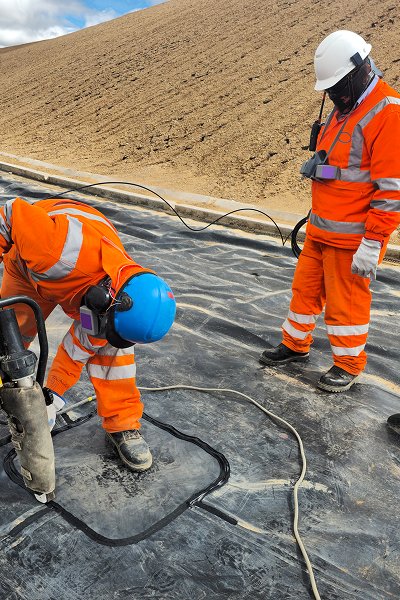Geocell structure
Geocell is a three-dimensional grid structure formed by a series of interconnected strips through heat welding, ultrasonic welding or bonding technology. During the construction process, the cell can be stretched and unfolded like an accordion to form a honeycomb three-dimensional frame, and the interior can be filled with soil, gravel, concrete or other materials to form a structurally strong composite layer.
Its basic structural features include:
Unit structure: Each cell unit forms a hexagon, rectangle or irregular shape, generally with a height of 5cm~20cm;
Foldability: compressed into blocks during transportation, stretched and unfolded during construction, saving transportation and on-site space;
Freedom of filling medium: can be filled with local materials such as loess, gravel, concrete, etc., to adapt to different geological environments;
Interconnectivity: multiple units are connected into a whole through connecting buckles or nails to enhance overall stability.

How Geocells Stabilize Slopes
Limit lateral displacement: Forming the "reinforced soil effect"
Soil often slides laterally under the action of gravity or external load, especially on slopes, and its shear failure surface often occurs in the shallow layer. Geocells constrain the lateral movement of filling materials through their three-dimensional honeycomb structure, thus forming the so-called "reinforced soil effect".
The soil is confined in each cell unit, forming a passive confinement effect;
When subjected to external force, the tendency of the filler to expand laterally is constrained by the cell wall;
The internal stress of the soil is redistributed, the equivalent cohesion is increased, and the shear strength is improved;
It is like laying a "fascia" in the soil, effectively suppressing overall sliding.
Increase the friction of the slope: improve the overall stability coefficient
After the geocell is laid on the slope, a rough, interlocking contact interface is formed between it and the base, which significantly increases the friction coefficient between the slope and the foundation.
The three-dimensional structure is close to the slope, and the bottom of the cell forms a composite friction structure with the surface;
The cells are fixed by connecting nails, anchors and other means to achieve anti-slip interlocking;
The upper load is transmitted to the lower bedrock through the cell, reducing local stress concentration;
The shear force required for the overall slope sliding is increased, which improves the safety factor.
Prevent surface erosion: Improve water erosion resistance
In rainy or frequently impacted slope areas, the topsoil is easily washed away, eventually leading to exposed slopes, loose structures, and landslides. Geocells effectively prevent this process by stabilizing the surface structure.
The filler inside the cell is stable and not easily washed away by rain or runoff;
Through the cell opening design, excess water is drained and pore water pressure is reduced;
Combined with vegetation planting, a dual anti-scouring system of "engineering + ecology" is formed;
It can be used in combination with non-woven fabrics and anti-seepage membranes to further improve waterproof and anti-scouring capabilities.
Load dispersion mechanism: Relieve stress concentration on slopes
There are often concentrated load sources such as structures or vehicles on the slopes. If not treated, local deformation or shear failure may occur. The composite structure of geocells can form an effective "rigid platform" in the vertical direction, dispersing and transmitting the upper load in the horizontal plane, effectively preventing local collapse or damage.
The cell wall material itself has a certain rigidity and elasticity;
After the filling in the cell is dense, it forms a whole with uniform strength;
The stress spreads to the surrounding area, reducing the concentrated load at the bottom;
It is especially suitable for areas with trails, steps or light structures on the slope.
Hydraulic stability and ecological compatibility: long-term sustainable protection
Modern slope reinforcement schemes increasingly emphasize green ecology, and geocells fit this concept perfectly:
The interior of the cell can be filled with grass seeds and soil to achieve slope greening;
The cell gaps promote the expansion of plant roots and further consolidate the soil;
The vegetation roots complement the cells to enhance soil and water conservation capacity;
In the long run, the self-recovery ability of the ecosystem is activated, forming a sustainable slope reinforcement system.
Highway Slope Stabilization Project
Project Background:The highway reconstruction and expansion project has steep mountain slopes along the route, which is a red soil landform. It is severely eroded by rainwater and the topsoil is very prone to landslides.
Problem Challenges:
High rainfall frequency leads to soil and water loss on the slope;
Vegetation restoration in exposed areas of the slope is difficult;
Traditional mortar-stone slope protection is expensive and has poor ecological properties.
Solution:
150mm high HDPE geocells are laid on the slope and filled with planting soil;
Combined with grass seed spraying, "structure + vegetation" double slope protection is achieved;
Anchor nails and anchor bar systems are used to reinforce the slope foot cells.
Effect Evaluation:
After two years of rainy season observations, no obvious sliding or soil erosion has occurred;
The vegetation coverage rate exceeds 85%, and the slope ecology has recovered well;
Construction costs are reduced by about 30%, and construction period is shortened by 40%.



